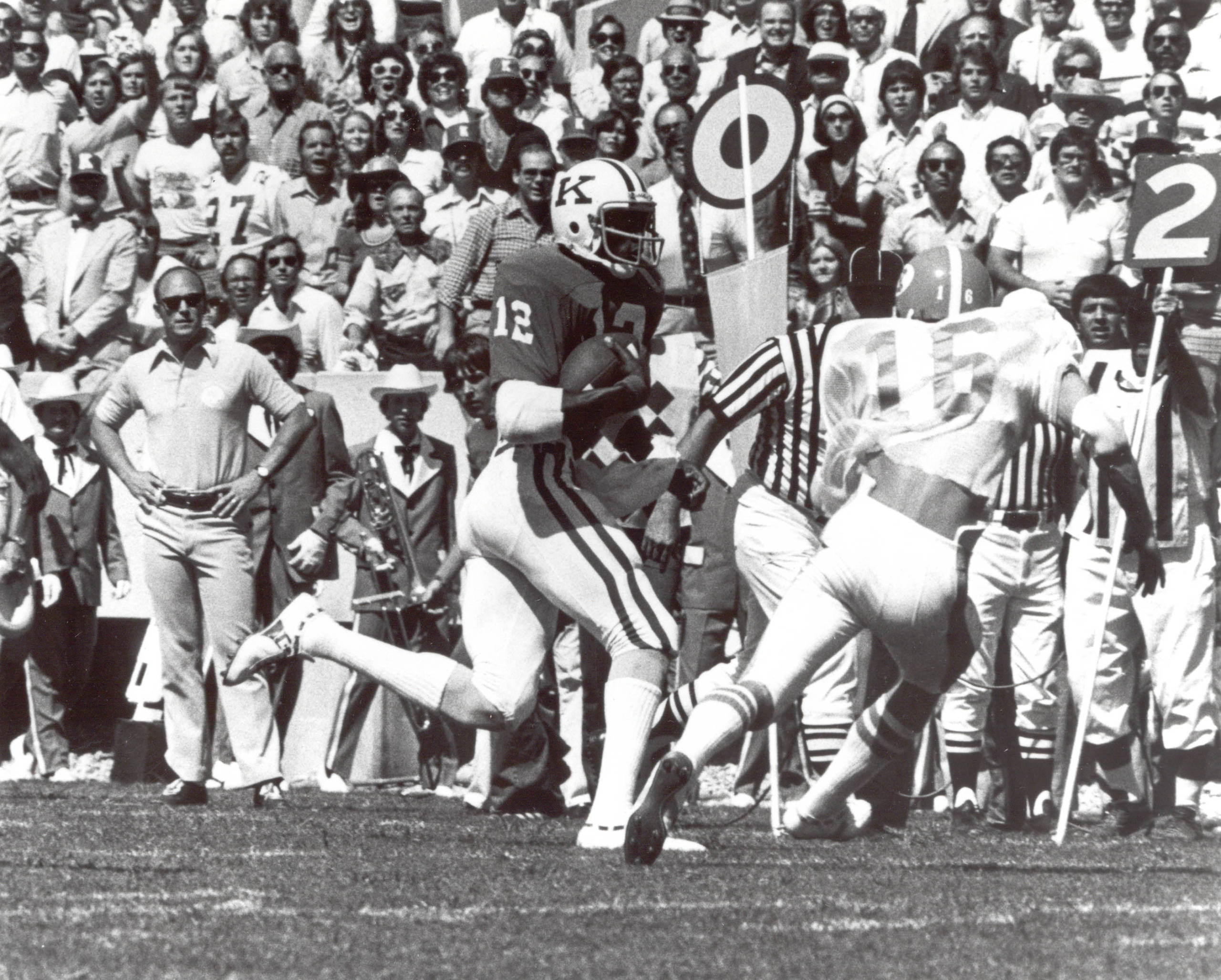
No Sonny, No Problem: A Look Back at the '76 Cats
Share
The 1976 Kentucky Wildcats will be in town to celebrate their historic season and Peach Bowl appearance at Saturday’s game vs. Mississippi State. In honor of the team, let’s take a game-by-game look at a memorable year.
The Kentucky Wildcats entered the 1976 season with a void on offense. The program’s all-time leading rusher, Alfred “Sonny” Collins, was no longer an option after his collegiate career ended in the previous season.
In total, the 1976 squad lost 70.3 percent of the team’s rushing yards from 1975. For a program that was heavily focused on a ground attack under the direction of head coach Fran Curci – the Wildcats ran the ball 84.3 percent of the time in his first three seasons at the school – finding a replacement loomed large heading into their season opener. Kentucky, with the emergence of quarterback Derrick Ramsey and outstanding defensive play, answered that question and many more to end of a loyal fan base’s postseason frustration.
The opener
The season could not have started any better for the Wildcats, with an easy defeat of Oregon State, 38-13, at Commonwealth Stadium. The game was not the most fundamentally sound, as each team committed six turnovers. The 25-point margin of victory was the program’s largest in a home season opener since 1951. Kentucky overwhelmed the Beavers in the game’s first 30 minutes, outscoring the opposition 38-7. The fast starts to games continued to be a theme throughout the season, with the Wildcats outscoring their opponents 87-10 in the first half of their eight victories. Junior quarterback Derrick Ramsey had his best scoring output of the season, accounting for all five of Kentucky’s touchdowns (three rushing and two passing).
Falling down and getting up
Kentucky followed up the season opener with a less than stellar performance against the No. 13 Kansas Jayhawks in Lawrence, giving up a season worst 401 yards on defense. Kansas was the first of seven teams that the Wildcats faced that season that were ranked in the Associated Press Poll, the most ranked opponents that the team had ever faced in a single season. The Wildcats needed to get back on the right track with another victory, and did so when they returned home to take on West Virginia. Despite a minus-two turnover margin, Kentucky was able to defeat the Mountaineers, 14-7. Running back Rod Stewart’s nine-yard rushing touchdown in the third quarter was the first touchdown on the season to not involve Ramsey, with the quarterback passing or rushing for the team’s first eight touchdowns.
A dominant upset
The Wildcats kept the momentum going when perennial powerhouse and 20th-ranked Penn State, led by legendary head coach Joe Paterno, came into town. Kentucky’s dominating performance was evident on the ground, outrushing the Nittany Lions 399-61 in their convincing 22-6 win. As a result of the Wildcats’ ground attack, two players had their first career 100-yard rushing games, sophomores Chris Hill (106 yard) and Stewart (103 yards). It was a run by quarterback Derrick Ramsey though that stole the show. In one of the most iconic moments of the season for the Wildcats, Ramsey fought through several Penn State defenders, with his jersey tearing apart in the process, to race 61 yards down the sideline to score, giving Kentucky a 22-0 lead in the third quarter.
A loss that became a win
Kentucky saw its winning streak end the very next week as the Wildcats lost to Mississippi State 14-7 in a neutral-site contest in Jackson, Mississippi. That result although would change in Kentucky’s favor in the near future. In May of 1978 the NCAA had declared that the Bulldogs had used an ineligible player, defensive lineman Larry Gillard, throughout the 1976 season. As a result, the Wildcats were retroactively given a victory for that contest.
Defense drives another upset
Kentucky then returned home to take on No. 16 LSU in a game that clearly showed that the Wildcats had more than just a running attack to guide them to victories. With Kentucky having their worst offensive performance of the season, amassing just a total of 210 yards, the defense picked up the slack. The Wildcats forced the Tigers into four turnovers, one of which was an interception by junior Dallas Owens that was returned 56 yards for the game’s first touchdown. Stewart tacked on two more rushing touchdowns as Kentucky defeated LSU, 21-7. It was the first time in school history that the Wildcats had defeated LSU with the Tigers ranked in the AP Poll.
Two top-10 defeats
The Wildcats’ difficult schedule finally caught up to them over the next two weeks with consecutive games to No. 10 Georgia and No. 5 Maryland. Despite outgaining the Bulldogs on offense, Kentucky’s five turnovers ended up being the difference in their 31-7 defeat. That ended up being the Wildcats’ only loss at Commonwealth Stadium that season. Kentucky then traveled to College Park, but their ground game was left behind in Lexington. The Wildcats had their worst rushing performance of the season, amassing just 119 yards, as the Terrapins won, 24-14. That Maryland team was coached by Jerry Claiborne, who ended up being Kentucky’s head coach starting in the 1982 season.
Furious finish
Kentucky rebounded from a disappointing fortnight with their best end-of-season stretch since 1954, winning its last four games, outscoring their opponents 70-9 over that span. The streak started with the Wildcats shutting out Vanderbilt, 14-0, in Lexington. Ramsey rushed for 118 yards against the Commodores, his second career 100-yard rushing performance, to aid in the Wildcats’ victory. Kentucky followed up that win with arguably their best all-around performance of the season against No.-15 Florida at Commonwealth Stadium. The Gators finished the season leading the SEC in both total offense (400 yards per game) and passing offense (162.1 yards per game), but had no answer for Kentucky’s relentless defense. Florida could only muster 154 yards of offense, including a meager 40 yards through the air. As impressive as Kentucky’s defense was, their offense was even better, racking up season-highs in both total offense (472 yards) and passing (139 yards). The Gators’ Berj Yepremian connected on a 42-yard field goal in the second quarter as Florida took the lead, 3-0. That was the only time in Kentucky’s eight victories that season in which they trailed their opponent. Kentucky ended up scoring 28 of the last 34 points, defeating Florida, 28-9.
The Wildcats then traveled down to Knoxville for their annual season finale against border rival Tennessee. The two teams did not put on a display of offensive efficiency, with a combined 24 punts, but Kentucky was able to put together one big play that was the difference in the game. Late in the first quarter, Ramsey connected on a pass to a wide open Greg Woods, who then darted 62 yards to the end zone. It ended up being the only score in a 7-0 shutout win for the Wildcats, while holding Tennessee to their worst offensive performance of the season (166 yards). It was Kentucky’s first victory over the Volunteers in Knoxville since 1964.
Back in a bowl
With a 7-4 record, including wins over three AP Poll-ranked opponents, the Wildcats were rewarded with their first postseason appearance since the 1951 season, ending their longest bowl drought in program history. Kentucky was going down to Atlanta to take on No. 19 North Carolina in the Peach Bowl. With almost six weeks between Kentucky’s season finale and bowl game, the Wildcats took advantage of their time getting prepared to defend ACC Player of the Year and the conference’s leading rusher, Mike Voight. The Wildcats were able to rearrange their focus after Voight injured his ankle in practice two days prior to the game.
Defensively speaking, Kentucky certainly saved its best for last, having one of its best defensive showings in school history, regardless of opponent. The Wildcats absolutely smothered the Tar Heels from start to finish, with North Carolina getting a measly 108 yards on offense. Kentucky’s ability to defend the pass was its greatest attribute that day, intercepting three of North Carolina’s passes. That’s as many passes as the Tar Heels completed to their own team.
Not to be outdone by the defense, running back Stewart had one of the school’s best individual offensive performances in a bowl game, rushing for 104 yards and three touchdowns. The yards and touchdowns were both school records for a bowl game. Stewart displayed his happiness after the game.
“I’m from Ohio and everyone talks about Ohio State,” Stewart said. “They kept saying, ‘Why go to Kentucky where you’ll never get any recognition?’ But they were wrong. Now that we have been in a bowl game and won and will get the national publicity, I can laugh in their faces.”
Kentucky could not have put together a better end to the season, shutting out North Carolina, 21-0.
Kentucky’s defense ended up shutting out three of its last four opponents, the most shutouts in a single season for the Wildcats since 1960. How did the Wildcats deal with the loss of Sonny Collins? They ended the season averaging 269.1 rushing yards per game, the second-highest total in school history. It was a balanced rushing attack for the squad, with four players amassing at least 500 yards. Ramsey led the team with 771 rushing yards, also the most in the SEC among quarterbacks. The Wildcats finally got the respect of the Associated Press, with a No. 18 ranking in the final AP Poll after not being ranked the entire season. It was Kentucky’s first appearance in the final AP Poll since the 1953 season. With their balanced rushing attack and exemplary defensive play down the stretch, Kentucky’s 1976 campaign is certainly one to celebrate.



